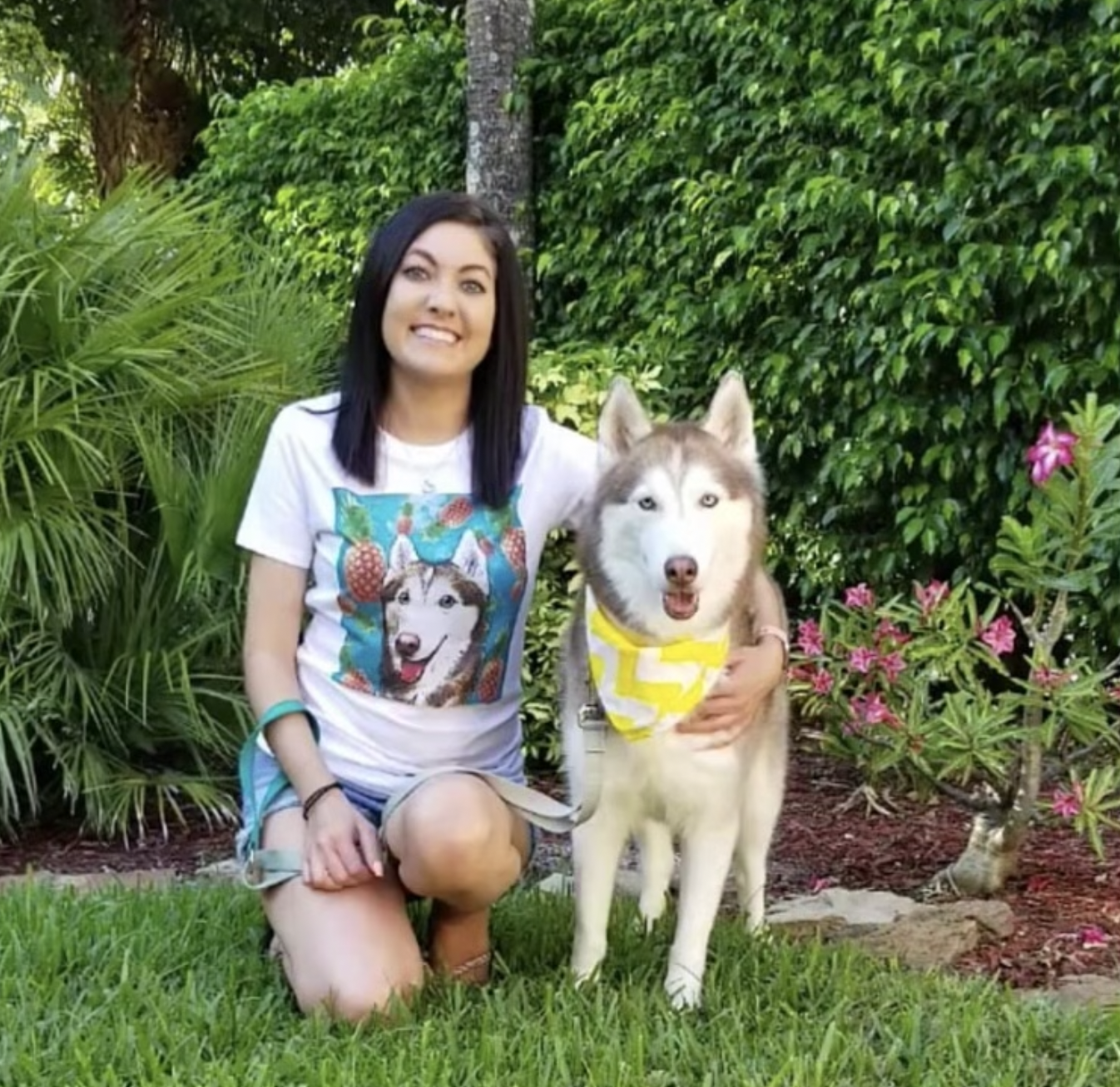For Pups With Short Attention Spans…
Dogs are pregnant for 58-68 days, or about two months. Dogs are first able to become pregnant during their first heat cycle around 5 to 6 months. Labor for dogs can typically last 4-24 hours. Breeding dogs can be an enormous and expensive responsibility so it is not recommended for inexperienced owners.
How long are dogs pregnant? Or wait, is it spelled pergnent? Prrreegnant, perhaps? Maybe this Youtube video could help us out. Okay, so now that this video covered the basics of all the ways not to spell “pregnant”, it’s time to get serious, you meme-loving weirdos. Here’s all the basics you need to know about dog pregnancy.
How Long Are Dogs Pregnant?


Short Answer: 58-68 days
Compared to our lengthy human pregnancies that last about 9 loooong months, dogs really luck out with a much shorter pregnancy, or gestation period, that lasts only about 58-68 days (approx. 2 months)1. You can typically expect a dog to give birth approximately 63 days after the day they mated; however, predicting the exact parturition date (a.k.a. day of birth) isn’t an exact science when it comes to dogs2. Knowing the date of mating can help with a rough guesstimate of when to expect puppies, but the pups are gonna be here in their own time—so, you might wanna avoid going out for margaritas and trivia that week.
If you’re unsure of the exact mating date due to an accidental pregnancy, or you’ve happened to come across a pregnant dog who has been abandoned—a tragically common fate for many pregnant dogs—a veterinarian can run tests (see below) to help you estimate when to expect birth.
When Can Dogs Become Pregnant?


Short Answer: Female dogs can become pregnant:
- During their first heat cycle around 6 months old (as early as 5 months old)
- Only when they are in heat (this isn’t always visibly obvious)
- If they have not been spayed
Dogs can become pregnant when they go into their first heat cycle—typically around 6 months old, but as early as 5 months old4. This does not mean that they should become pregnant or that their body is ready to carry puppies at this age, but it does mean that they’re capable of becoming pregnant this early—often accidentally, when pet parents are unaware of the possibility. If you’ve ever happened to see a dog wearing what looks like a doggie diaper, there’s a good chance she’s in heat.
In terms of something you’re probably already familiar with, both dogs and humans experience cycles of hormones that lead to the release of egg(s) ready to be fertilized. A dog’s heat cycle, also called an estrus cycle, typically lasts 18-21 days in total and only occurs approximately once every 6 months, depending on breed. Smaller breeds may occasionally have 3 or even 4 heat cycles in one year. You’ve probably heard phrases like “in heat” or “she’s in heat” when referring to this time. A dog is only fertile and capable of becoming pregnant when she’s in heat, but it’s not always visibly obvious to pet parents when this is happening, so it’s important to understand the stages of dog’s cycles to avoid unwanted pregnancies.
| Humans | Dogs | |
| Name of Cycle | Menstrual Cycle | Estrus Cycle (“in heat”) |
| How Often Cycle Occurs | Once a month (28 days) | Once every 6 months (every 3 or 4 months in some smaller breeds) |
| How Long Cycle Lasts | ~3-7 days | ~18-21 days |
There Are 4 Stages In A Dog’s Heat Cycle:
- Proestrus – Start of the heat cycle, lasting about 7-10 days. Signs to watch for: swollen vulva (outer part of her female doggie bits); bleeding will begin; females begin attracting males, but won’t allow their advances4. This is when you may start to notice male dogs intensely up in her business or attempting to mount her (doggie humping). During this time she’ll reject advances and possibly warn males aggressively. She ain’t in the mood for that nonsense.
- Estrus – Mating stage, lasting about 5-10 days (but can last anywhere from 3-21). Signs to watch for: bleeding will become lighter then stop; males and females will be mutually attracted4; The Lion King’s “Can You Feel The Love Tonight” may start playing out of thin air. This is when mating occurs (the male and female will become “locked together” for 15-30 minutes – also called “the tie”). Ovulation typically occurs 2-3 days after mating4.
- Diestrus – Lasts 10-140 days, depending on whether the dog becomes pregnant or is in resting phase4.
- Anestrus – Resting period between heat cycles4. She cannot become pregnant during this stage.
How To Tell If Your Dog Is Pregnant
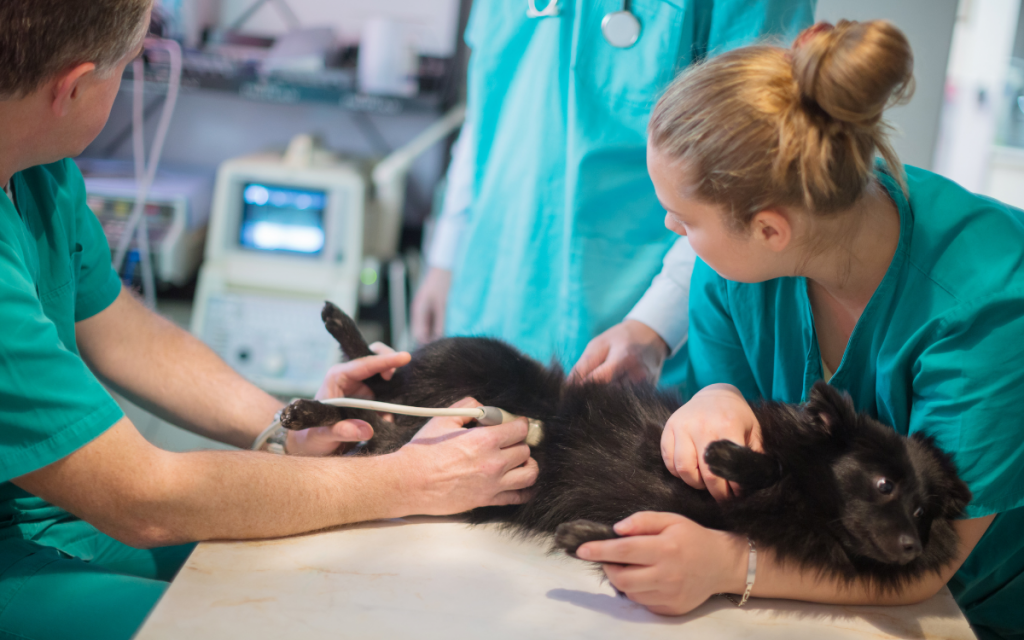

Dogs don’t have convenient at-home pregnancy tests like we have for humans. Even if they did, could you imagine trying to chase your dog around to get them to pee on a stick!? Luckily, this is where vets can help. If you planned your dog’s pregnancy, knowing the exact mating date will help your vet know how to test to confirm a pregnancy. Depending on how far along a dog may be in their pregnancy, a vet may use these different methods for testing and confirming a dog is pregnant:
- Hormone tests
- Palpation
- X-ray (only reliable after day 45 of pregnancy, when the puppies’ bones start to mineralize and can be seen on x-ray). X-rays are the best way to count how many puppies are in there, since you can see all of their noggins at the same time!
- Ultrasound (this can possibly diagnose a pregnancy earlier than day 45, but won’t be able to reliably count how many puppies are in there – you can’t see them all at once, and they’re usually wiggly.
Signs That A Dog Is Pregnant:
When a dog is far enough along in pregnancy, it doesn’t take a rocket scientist to determine they are, in fact, pregnant. However, if you notice any of the signs below, you’ll want to make a vet visit for confirmation and to make sure that mom and puppies are healthy:
- Weight gain
- Enlarged nipples
- Swollen Stomach
- Change in appetite
- Irritability
- Vomiting (in the first few weeks)
What Are The Stages Of A Dog Pregnancy?
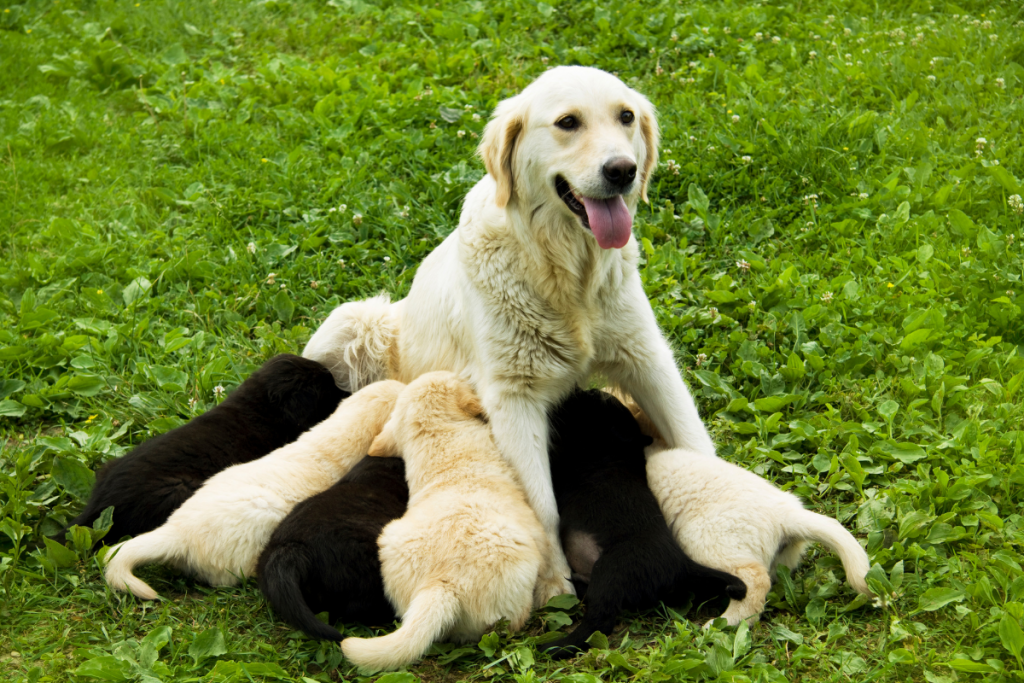

As we mentioned in the beginning of this article, a dog pregnancy, or a dog’s gestation period, lasts 58-68 days. So, what happens during this time and what should you expect? Here’s an approximate breakdown of the timeline:
Month 1 Of Dog Pregnancy:
The first 3 weeks will basically be business as usual—she won’t show many signs of pregnancy yet, regular exercise is fine without restriction6, and her appetite may stay the same. However, she’s going to gradually develop an increased appetite throughout pregnancy and will require food with additional nutrients. This is a good time to switch her to a diet formulated for growth, as their food intake should be puppy food or food made specifically for pregnant dogs6. Around week 4, she’ll begin showing signs such as vomiting—similar to morning sickness—and possibly a lack of appetite. This should only last for about a week. Although these can be normal in pregnancy, consult your vet if vomiting and lack of interest in activities lasts longer than a week, as they can also indicate more serious problems6.
Related Article: Puppy Food vs. Adult Dog Food: What’s The Difference?
What To Do During Month One:
- Weeks 1-3 – Regular exercise, gradually switch diet to formula for growth (puppy food)
- Week 4 – Expect vomiting and lack of appetite. Consult vet if this lasts longer than 1 week
| Puppy Development During First Month5 | |
|---|---|
| Day 11 | Embryo travels to uterus |
| Day 16-18 | Embryo embedded into uterus |
| Day 22-24 | Fetus begins to take shape and can be detected by palpation (a.k.a. vet presses into belly to manually feel for puppies) |
| Day 24-25 | First flickers of heartbeat |
| Day 28 | First reliable day for vet to detect heartbeat |


Month 2 Of Dog Pregnancy:
Around days 35-45 of pregnancy you should schedule a check-up with her veterinarian to confirm pregnancy and determine the number of pups expected1. At the start of this month, she’ll need twice as much food as usual1. If you have not already switched to a growth formula (puppy or pregnancy-specific food), you should do so now. You’ll want to restrict exercise to only light walkies to keep her strength up without causing stress6. Begin setting up a whelping box or comfortable, quiet area that feels like home to the mother for her to give birth and care for her pups in the first few weeks. It’s very important to isolate her from all other dogs three weeks before her expected delivery date—even other household dogs—to prevent illnesses that can hurt the puppies, such as herpesvirus1.
What To Do During Month Two:
- Vet check-up to confirm pregnancy and number of puppies expected around days 35-45
- Double her typical amount of food. Switch to puppy or pregnancy-specific formula if you haven’t yet.
- Restrict exercise to light stress-free walks
- Set up place for her to give birth
- Three weeks before birth isolate her from all dogs
| Puppy Development During Second Month5 | |
|---|---|
| Day 36 | Limbs detectable |
| Day 39-47 | Eyes, kidney, liver detectable |
| Day 46-50 | Skeleton (skull and spine) is distinct and detectable by x-ray. Number of puppies detectable by x-ray. |
| Day 58 | Pelvis detectable by x-ray |
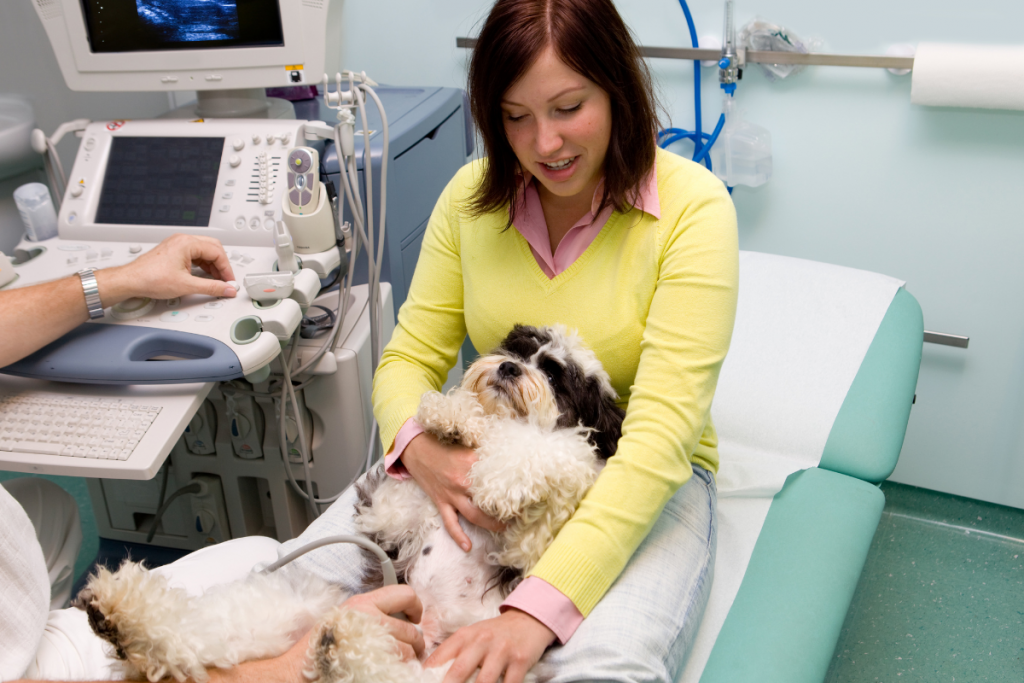

Month 3 Of Dog Pregnancy:
At this time, start preparing for birth at any moment. Puppies are not always on a precise schedule. You’ll want to start taking her rectal temperature (yup, up her bum) regularly (if tolerated!). Once it drops below 100°F (37.8°C) you can expect labor within 12-24 hours1. Continue to isolate the mother from all dogs 3 weeks before birth up until 3 weeks after birth to avoid her contracting herpes virus1.
What To Do During Month Three:
- Regularly check rectal temperature. Work with your vet to make a monitoring plan.
- Prepare for labor within 12-24 hrs once temperature drops below 100°F
- Isolate mother from all dogs 3 weeks before birth and 3 weeks after birth
- Expect mother to refuse food, become restless, and begin to nest nearing labor
| Puppy Development During Third Month5 | |
|---|---|
| Day 60 | Teeth detectable by x-ray |
| Day 62 | Mom starts nesting behaviors |
| Day 63 | Early birth possible. Pre-planned c-sections may also be safely performed by veterinarian. |
| Day 65 | Typical birthing date |
| Day 68 | Over-due/late birth |
How Long Are Dogs In Labor?
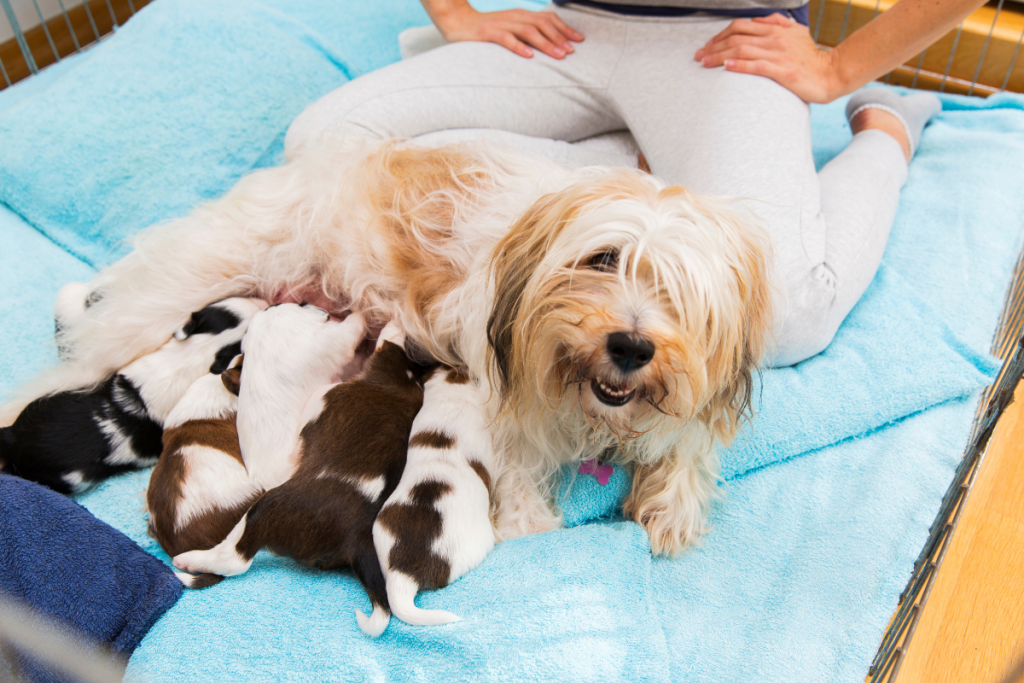

Stage One – Stealth Uterine Contractions And Nesting (Lasts 4-24 hrs)
This stage occurs about 62 days after mating and will last anywhere from 4-24 hours5. During this time uterine contractions will begin, but won’t be outwardly noticeable at this point. Although these stealthy contractions themselves aren’t noticeable, dogs will begin to show some signs that they’re currently in this stage and preparing for puppies to be born5,7:
- May become vocal
- Digging
- Restlessness/pacing
- Changes in behavior, may become defensive
- Avoiding people, looking for a quiet spot alone
- May begin nesting
- Possible vomiting
Stage Two – Birthing (Lasts 1-24 hrs)
During this stage, mom is actually birthing her puppies. This occurs around days 63-68 after mating. It’s very important to know how many puppies are expected so you know when she’s done, and if there’s any trouble. One puppy will be delivered at a time. You can usually expect one pup every 45-60 minutes1(can be as little as 20min or as long as 4hrs if she stops to rest7. She will strain hard for 10-60 minutes to deliver each pup1. Here’s what you can expect during birth:
- Puppies will be born covered in a membrane (gooey covering) that needs to be removed immediately to avoid suffocation1. Mom may try to remove it herself, but if she’s unable or unwilling then it’s time for you to step in to remove it.
- You may tie the umbilical cord in a knot about an inch away from the pup and cut on the side of the knot furthest from the puppy. Do not pull on cord1!
- Puppies may be born tail first or head first, both are normal1.
Stage Three
Newborn puppies are all here! After all puppies have been birthed, the placenta will be delivered in the third stage of labor. Your dog may try to eat the placenta. Although this is not really harmful, you should avoid letting her eat it, because it often results in vomiting1 and more of a mess for you to clean!


When To Call The Vet
Problems occasionally pop up throughout pregnancy and labor. It’s important to understand what events are considered abnormal and when to call the vet for help1:
- If strong contractions occur longer than 30-60 minutes with no puppy being birthed
- More than 4 hours pass without a puppy being birthed when you’re expecting more pups
- She’s in obvious, extreme pain
- She’s been pregnant longer than 70 days without going into labor
It’s also very important for you to make sure you have established care with a vet. Work with your vet to understand what red flags to watch for, and when they suggest you call for help.
Can I Breed My Dog If I Don’t Have Experience?
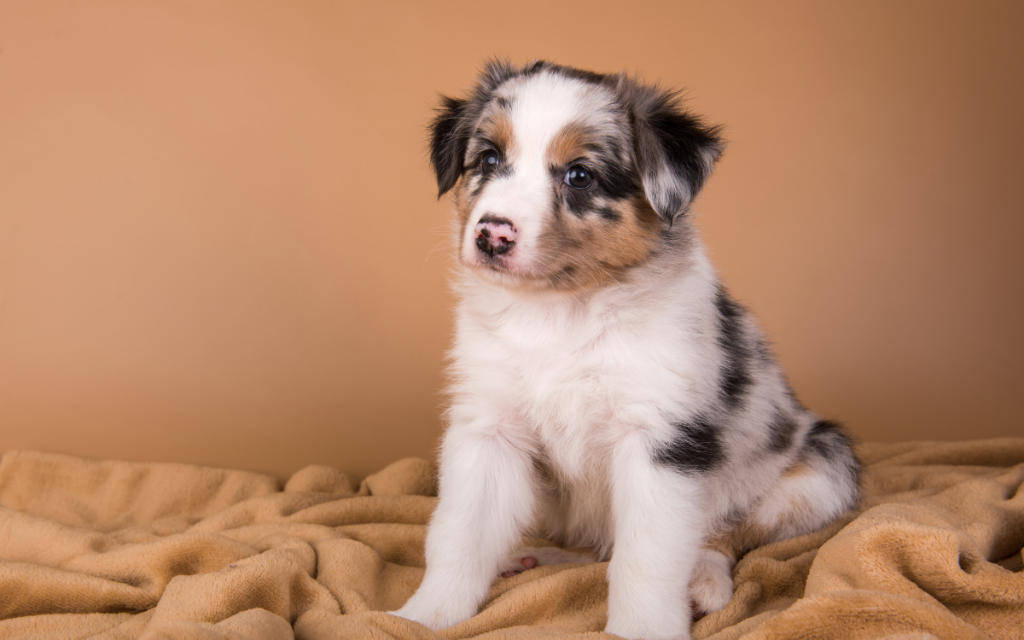

Breeding healthy, well-cared-for dogs is a huge responsibility and commitment. Breeding dogs without experience or in-depth knowledge can lead to big, sad problems:
- It Can Lead To Newborn Puppies With Health Problems – This can go wrong in so many ways. For example, did you know if you breed any two merle dogs, their puppies will have a 25% chance of being deaf3? Without genetic testing in advance, there’s no way to know what underlying health issues you’ll be breeding into a new generation of dogs. Many of these conditions don’t show until later in a dog’s life and would be unapparent during breeding years.
- It Costs A Lot Of Money And Time – All too often, someone will see the price of purebred puppies and get the idea that it would be a quick way to make some money. But this is actually far from the truth. What people fail to consider is the thousands of dollars (upward of $7,000) they’ll be spending on breeding expenses like basic supplies and vet bills. Not to mention, this entire process takes A LOT of time!
- If The Puppies Aren’t Adopted Out You’re Contributing To Overpopulation – This is a point that can’t be overlooked. What happens if you decide to breed your dog and no one wants the puppies? Or what do you do if you sell a puppy that soon develops health issues, and the buyer wants a refund? Oftentimes these puppies, or even the unwanted mother, end up in animal shelters. According to the ASPCA, each year there are more than 3 million dogs in shelters across the U.S. In some cases, dogs can be euthanized due to overcrowding at shelters. Irresponsible breeding is a major contributor to overpopulation.
- You Could Find Yourself In Trouble With The Law – Although breeding dogs in the United States is legal, there are still scenarios where you could find yourself tangled up in court. Neglecting or abusing animals under your care, especially when over-breeding and breeding unhealthy dogs, can be considered animal cruelty and is punishable by law. You also need to make sure you’re following local and federal laws for licenses and tax compliance.
- Your Dog May Not Be Healthy Enough For Pregnancy – Your dog may not be strong or healthy enough to carry a litter without risk to her own health. For instance, if your dog is at an unhealthy weight, improper age, or has her own health issues, she may have trouble carrying puppies to term—putting her own life at risk, as well as the puppies’.
- Your Dog May Require Emergency Help During Delivery – some dogs, just like people, end up needing an emergency c-section. This is not only expensive, but also an invasive surgery that she will need to recover from. Some breeds of dogs must deliver via c–section: a natural birth is impossible, and would cause both mother and puppies to die.
- Intact Female Dogs Are Susceptible To Life-Threatening Uterine Infections – keeping female dogs intact (rather than spaying them) comes with some big health risks that should be balanced against the intention and purpose of breeding them.
This article has been reviewed by Margo Hennet, DVM.
Margo Hennet, DVM, cVMA, and veterinarian at BARK is a canine nutrition, health, & wellness connoisseur. She has a combined 10 years of experience in clinical medicine, research, and education—that’s 70 dog years of know-how—and graduated from Colorado State University as a Doctor of Veterinary Medicine. She completed specialized training in internal medicine prior to working as a general practitioner in Colorado, has authored peer-reviewed publications and textbook chapters, holds certification in veterinary medical acupuncture, and is a member of the American Academy of Veterinary Nutrition and American Veterinary Medical Association.
Sources:
1 Brooks, Wendy. “Birthing Puppies.” Veterinary Partner, VIN, 27 Oct. 2021, https://veterinarypartner.vin.com/default.aspx?pid=19239&id=4951546.
2 Kim, YeunHee, et al. “Parturition Prediction and Timing of Canine Pregnancy.” Theriogenology, U.S. National Library of Medicine, Nov. 2007, https://www.ncbi.nlm.nih.gov/pmc/articles/PMC2099502/.
3 Strain, G.M.; et al. “Prevalence of Deafness in Dogs Heterozygous or Homozygous for the Merle Allele.” Wiley Online Library, Journal of Veterinary Internal Medicine, 3 Mar. 2009, https://onlinelibrary.wiley.com/doi/10.1111/j.1939-1676.2008.0257.x.
4 Bukowski, John A., and Susan Aiello. “Breeding and Reproduction of Dogs .” Merck Veterinary Manual, Merck Veterinary Manual, 7 July 2022, https://www.merckvetmanual.com/dog-owners/routine-care-and-breeding-of-dogs/breeding-and-reproduction-of-dogs.
5 Concannon PW. “Canine Pregnancy: Predicting Parturition and Timing Events of Gestation.” IVIS, Current Veterinary Therapy, Small Animal Practice, Vol. X, 9 May 2000, https://www.ivis.org/library/recent-advances-small-animal-reproduction/canine-pregnancy-predicting-parturition-and.
6 Brooks, Wendy. “Pregnant Dog Care.” Veterinary Partner, VIN, 31 Aug. 2021, https://veterinarypartner.vin.com/default.aspx?pid=19239&id=4951916.
7 Concannon, Patrick W. “Understanding and Monitoring Canine Pregnancy .” VIN, World Small Animal Veterinary Association, 2005, https://www.vin.com/apputil/content/defaultadv1.aspx?id=3854215&pid=11196.

